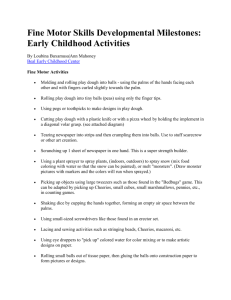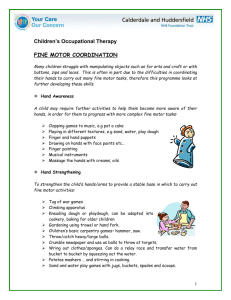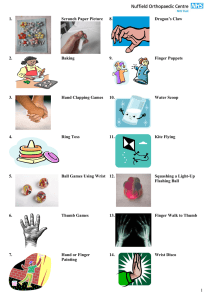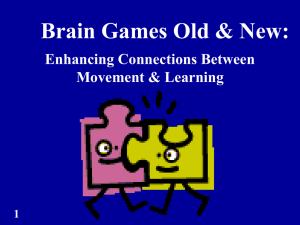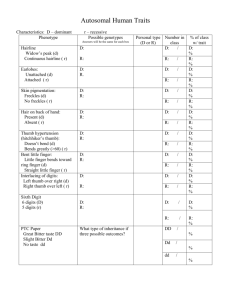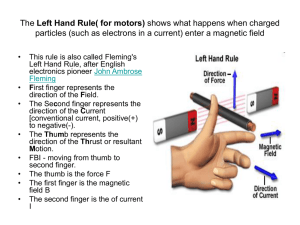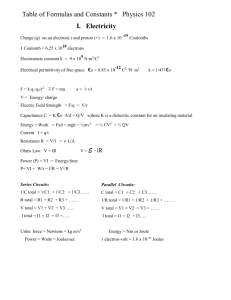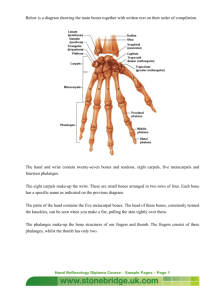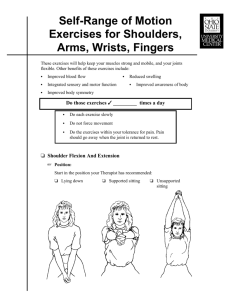Improve hand strength and Fine motor skills
advertisement
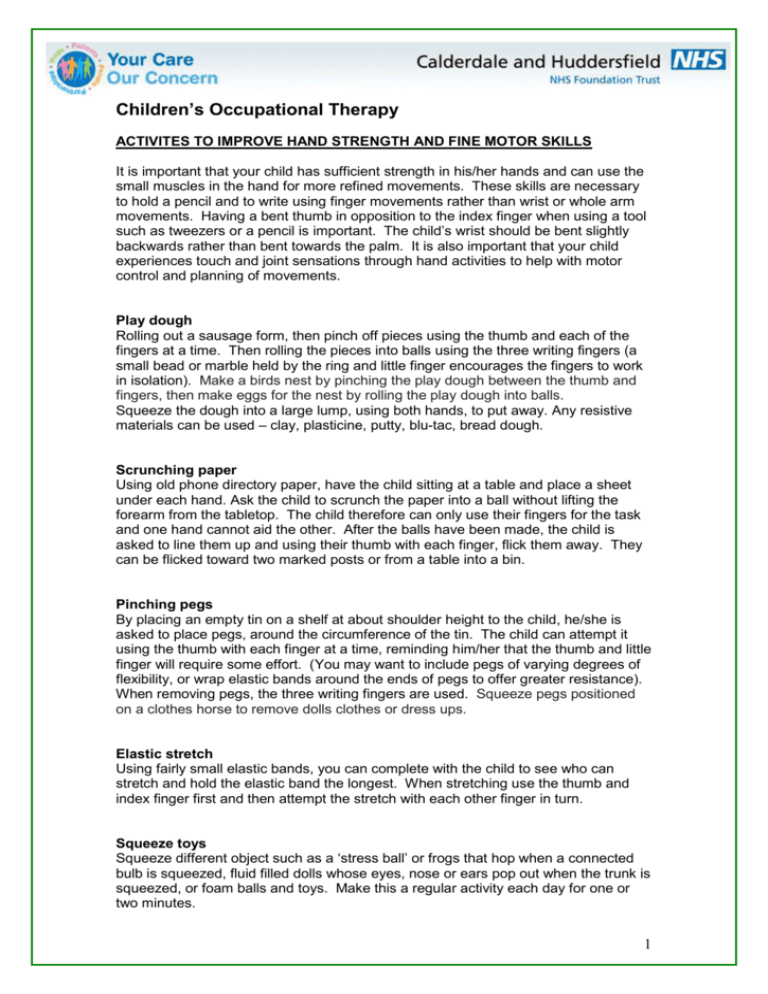
Children’s Occupational Therapy ACTIVITES TO IMPROVE HAND STRENGTH AND FINE MOTOR SKILLS It is important that your child has sufficient strength in his/her hands and can use the small muscles in the hand for more refined movements. These skills are necessary to hold a pencil and to write using finger movements rather than wrist or whole arm movements. Having a bent thumb in opposition to the index finger when using a tool such as tweezers or a pencil is important. The child’s wrist should be bent slightly backwards rather than bent towards the palm. It is also important that your child experiences touch and joint sensations through hand activities to help with motor control and planning of movements. Play dough Rolling out a sausage form, then pinch off pieces using the thumb and each of the fingers at a time. Then rolling the pieces into balls using the three writing fingers (a small bead or marble held by the ring and little finger encourages the fingers to work in isolation). Make a birds nest by pinching the play dough between the thumb and fingers, then make eggs for the nest by rolling the play dough into balls. Squeeze the dough into a large lump, using both hands, to put away. Any resistive materials can be used – clay, plasticine, putty, blu-tac, bread dough. Scrunching paper Using old phone directory paper, have the child sitting at a table and place a sheet under each hand. Ask the child to scrunch the paper into a ball without lifting the forearm from the tabletop. The child therefore can only use their fingers for the task and one hand cannot aid the other. After the balls have been made, the child is asked to line them up and using their thumb with each finger, flick them away. They can be flicked toward two marked posts or from a table into a bin. Pinching pegs By placing an empty tin on a shelf at about shoulder height to the child, he/she is asked to place pegs, around the circumference of the tin. The child can attempt it using the thumb with each finger at a time, reminding him/her that the thumb and little finger will require some effort. (You may want to include pegs of varying degrees of flexibility, or wrap elastic bands around the ends of pegs to offer greater resistance). When removing pegs, the three writing fingers are used. Squeeze pegs positioned on a clothes horse to remove dolls clothes or dress ups. Elastic stretch Using fairly small elastic bands, you can complete with the child to see who can stretch and hold the elastic band the longest. When stretching use the thumb and index finger first and then attempt the stretch with each other finger in turn. Squeeze toys Squeeze different object such as a ‘stress ball’ or frogs that hop when a connected bulb is squeezed, fluid filled dolls whose eyes, nose or ears pop out when the trunk is squeezed, or foam balls and toys. Make this a regular activity each day for one or two minutes. 1 Particular activities for pinch strength Play finger games such as incy wincy spider. Do up buttons on pyjamas and clothes. Use tweezers to pick up small beads or toys and put them into a container. Remove coins from a purse one at a time. Encourage your child to hold an object (a coin or marble) against the palm of her hand with her ring and little fingers whilst doing some of the above activities. Tear up coloured paper for pasting or collage activities. Threading activities such as beads or lacing cards. Building and then pulling apart pieces with duplo and lego. Undo and do up nuts and bolts Squeeze clothes pegs to remove them from the rim of a peg basket (or icecream container) Use stickers or sticky tape to stick things down. Water plants with a spray bottle; squirt a water pistol at a target. Wind up toys Child deals out cards when playing games Tie up a balloon Art activities that require colouring, scribbling with crayons or pencils. Colour over coins or templates and other surfaces. do up zips on pencil cases, bags, clothing squeeze toothpaste onto brush peel orange open up pop top drink bottles open yoghurt containers, and other packets use a can opener use a pipette to put coloured cordial into water Activities that strengthen the wrist Encourage your child to draw or write, as much as possible, on a vertical surface as this can help your child to achieve a good wrist position. (Use an easel, blackboard, or tape some paper to a wall). Encourage your child to do activities vertically. For example, placing stickers on a window or a piece of paper taped to the wall, playing Connect 4 or threading activities. Rolling and kneading play dough. Wrist lifts – place your child’s arm on the table and hold his arm. Encourage them to make a fist and bend the wrist back as far as possible. 2
